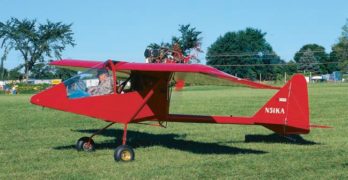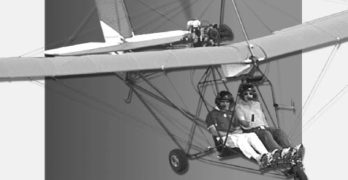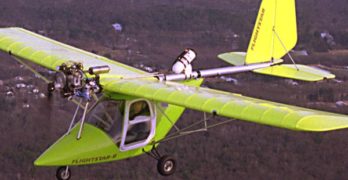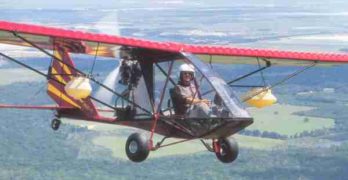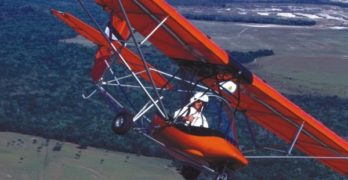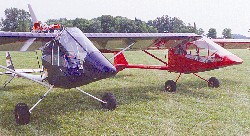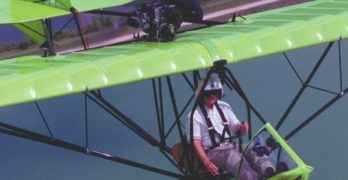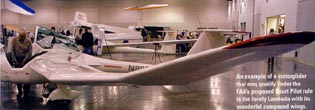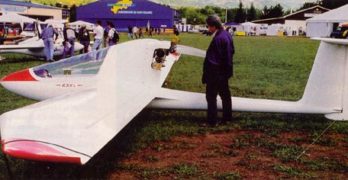FACING THE BUYING DECISION, PART II
Last time we discussed the pilot (you!); this time we discuss the many types of aircraft choices you have. In the last installment, we’ll put these together and help you narrow your choices to a few models.
What Kind of Pilot Are You?
Let’s just say you actually know yourself. While this sounds like a comment that deserves a “Duh!” response, don’t be too quick to judge. If every pilot or buyer of aircraft knew what they needed or wanted, my job would be easier. But it isn’t so. Most pilots know something about what they want, but many don’t have enough information to make the best decision.
Some readers are “experts.” A good many ultralight or light plane enthusiasts have been around long enough and owned enough variety of ultralights to know what they like.
These veteran sport aviators represent a lot of combined experience.
Search Results for : flight design ct
Not finding exactly what you expected? Try our advanced search option.
Select a manufacturer to go straight to all our content about that manufacturer.
Select an aircraft model to go straight to all our content about that model.
How-to-Buy a Lightplane — Part 1 of 3
WANT TO BUY A LIGHTPLANE?
Task Can Be Daunting, Yet Rewarding
I’m one lucky pilot. I love airplanes and get to fly more of them than the average sky jockey. Writing pilot reports for several magazines has given me the opportunity to fly about 250 different aircraft in the last 23 years.
This makes me a “Master of None” type of pilot (except in my own planes) but does give me a feel for the huge variety of light airplanes you can buy.
The choices are fantastic. Counting the whole world of sport aircraft, you can have just about anything you want| and that’s the problem. What to buy?
TRYING TO HELP
At every airshow I attend, and through phone calls between airshow, pilots often make a request: “You’ve flown all these lightplanes, which one should I buy?”
Frankly, the question makes me uncomfortable.
While I appreciate the feeling of confidence some pilots place in my experience, telling someone what to buy is a sure way to be considered wrong eventually.
The First Two Ultralights with the New HKS Engine
It isn’t often I can do “scouting party” duty on engines. Powerplants aren’t normally my focus. They
are a necessity for flight, but they aren’t my main attraction. A great many pilots I’ve met appear to be just the reverse: They are extremely interested in engines.
I enjoyed the chance to fly behind the first European and first American installations of the new 60-hp HKS 700E 4-stroke from Japan’s HKS Company Ltd. With that in mind, this pilot’s report is rather different. We’ll look at this new engine on two different aircraft.
As all Ultralight Flying! readers know, Rotax has enjoyed great success for more than a decade as an ultralight engine supplier. After dominating the 2-stroke market, Rotax introduced the 81-hp Rotax 912 4-stroke, which has become a popular powerplant choice for sport aviation aircraft.
Is a 4-Stroke Better?
All 4-stroke engine manufacturers trumpet their advantages over 2-strokes: lower fuel consumption, quieter operation, longer time between overhaul, and reliability.
ASAP — Chinook Plus 2
Long one of Canada’s best loved ultralights, the Chinook – formerly designed and built by Birdman – is another of the country’s designs saved by the Holomis family when they went acquiring ultralight aircraft companies to complement their successful machining enterprise in British Columbia.
A simple design with lines unlike any other ultralight I’ve flown, the aircraft has pleasing characteristics that most pilot will enjoy. Larger aviators especially will like the enormous cabin of the Chinook. And like other Canadian designs, the Chinook’s sturdy triangulated construction allows it to operate as a bush plane from almost any open space. Consequently, ASAP likes to show Chinooks with tundra tires or floats, both of which add to the rugged good looks.
The wide open cabin is surrounded by well supported clear Lexan giving you a panoramic view from either seat. Tandem aircraft often cramp the aft seat and don’t give it the best visibility, but Chinook sets a new standard.
Getting Up On A Breese
A M-Squared solidifies its position in the ultralight industry, the company rounds out its line of models with a pair of single-seaters to complement two 2-seaters already completed.
Welcome to fresh Mississippi Breeses.
M-Squared was born of a collaboration of 17-year Quicksilver veteran Paul Mather, and South Mississippi Light Aircraft (SMLA) owner Ronnie Smith. Mather started and solely owns M-Squared, but the two men have established a complementary working relationship.
Ronnie Smith and his wife built their SMLA operation into a regional powerhouse, selling Quicksilvers and other models through a chain of subdealers. Smith also established the southern enterprise as one of the few official American Rotax sales and service outlets and is also a supplier of many ultralight accessory items.
Mather conceived how Smith’s presence in the business might be combined with his own depth of experience and M-Squared rose as powerfully as the early 80-hp Rotax 912-equipped aircraft he debuted in the spring of 1997.
King and Kolbra
The King and Kolbra
The New Kolb Aircraft Company didn’t make a new model. They made two. But don’t judge by the photos accompanying this sidebar.
The red Kolbra was built by Lite Speed Aviation, a group based only an hour away from The New Kolb Aircraft Company. The distinctive orange-and-blue Kolbra is the factory creation. Finished off as professionally, I found some irony in that the newest model was not the factory one.
The Lite Speed model is the ultralight trainer version, and that’s precisely how Lite Speed plans to use it. New Kolb’s factory edition is an example of the King Kolbra, which will require FAA registration and an FAA pilot’s certificate.
In truth, besides the beefy Australian 80-hp Jabiru engine (versus the Austrian Rotax), the main differences between the two examples relate to the nose jobs. From the front seat aft (ignoring the engine), the two planes are all but identical except for paint and upholstery.
Golden Circle Air’s T-Bird I Is Easy On Pilots
Ten years ago, in the spring of ’93, I flew and reported on the nosewheel T-Bird I. Part 103 was barely 10 years old then and Sport Pilot/Light-Sport Aircraft concepts were a decade in the distant future.
This month we’re going to take a look at the taildragger T-Bird model. The good news through this passage of time is that the T-Bird I remains a delightful aircraft to fly. Anyone entering ultralight aviation should consider this plane among the fleet of possibilities.
Maybe you’re a bit overwhelmed by the steady stream of talk about FAA’s proposed Light-Sport Aircraft rule. The concept may be a bright light on the aviation horizon, but with another 6 months or more to wait, the patience of many pilots is wearing thin.
Even though I’m excited about this proposed new class of aircraft, I remain a true believer in the lighter, simpler, less expensive theory of ultralight aircraft.
AirSports Expo 2002
AirSports Expo attracts a large crowd and many vendors.
On the first day in Ontario, California, you could see this was going to be the largest AirSports Expo yet. In the shadow still lingering from September 11, many wondered and worried about participation and attendance, but the concern was baseless. A flurry of activity in the last few weeks before the show brought so many requests for exhibit space that the already designed floor plan had to be scrapped and redrawn.
More than 2200 pilots and other visitors saw the exhibits of 65 vendors. While still small next to Sun ’n Fun or AirVenture Oshkosh, this was a good turnout. The range of vendors included many aircraft suppliers and all manner of accessories and informational products.
Gathering of Eagles
AirSports Expo represents the combined efforts of the Soaring Society of America (SSA), the U.S. Ultralight Association (USUA), and the U.S. Hang Gliding Association (USHGA).
Ultralight Motorgliders
The ultralight motorglider evolution continues in Europe.
Ultralight motorgliders are as rare as hen’s teeth in the U.S., but Europe is blessed with several choices that nicely complement high-end, high-priced full-size motorgliders. While America has the lovely Esprit from Aero Dovron, our soaring friends across the Atlantic continue to lead this specialized market.
Full-size (higher-weight) motorgliders start at more than $100,000 and can surpass $200,000. Those who can afford them are surely thrilled with such beautiful machines, but most of us can’t spend that kind of money regardless of their superb performance.
However, at $20-$30,000 ready-to-fly, a clean self-launching soaring aircraft is more affordable. Like their larger siblings, these efficient designs can also cruise under power respectably well, giving them broader appeal than pure gliders.
Noins’ Excel
One of the newest of the breed is the Excel from France’s Noins Aeronautiques Alpaero. Based in beautiful Tallard in the French Alps, Noins is revered by French soaring pilots.
Ultralight Rotorcraft? Here are Two
America is a great country, most pilots agree. We can fly our planes all over (except in TFRs) without special permission from the government. Pilots in many countries don’t have this privilege. We can fly all manner of aircraft, from factory-built, certified models to kitbuilt machines to ultralights.
We also have several regulatory programs under which we can fly our planes. You can use your pilot’s license under Part 61 and operate under Part 91. You will soon be able to get a sport pilot license that won’t require a medical and fly a light-sport aircraft with industry-devised certification (sanctioned and approved by the FAA).
Or you can operate under Part 103, the least-burdensome regulation in the flying world. All of Part 103 can easily be printed on two pages. Remarkable! After 21 years, the FAA’s simplest rule is still going strong. One proof is that designers keep introducing aircraft that fit FAR 103’s definitions.
- « Previous Page
- 1
- …
- 132
- 133
- 134
- 135
- 136
- …
- 145
- Next Page »


